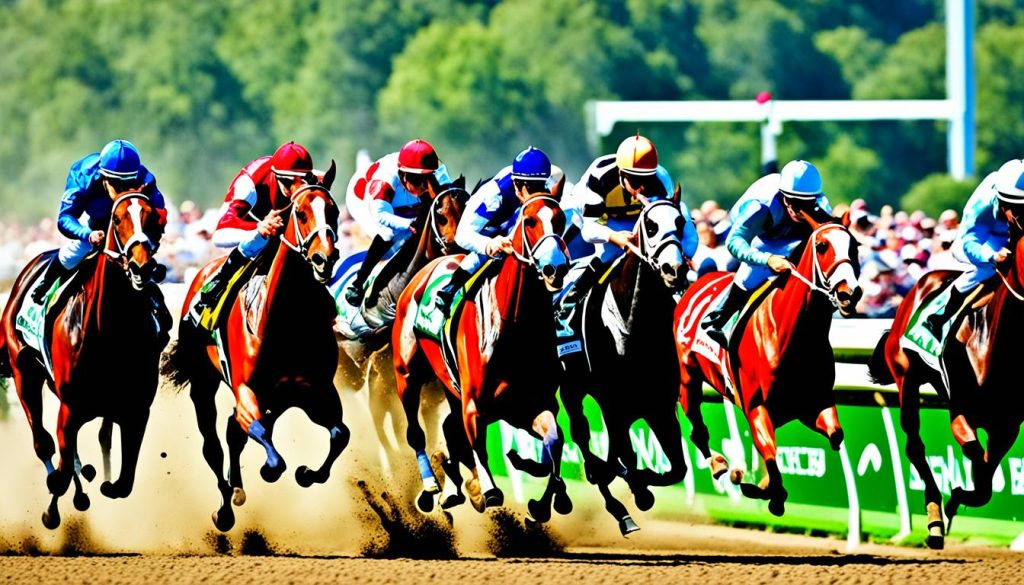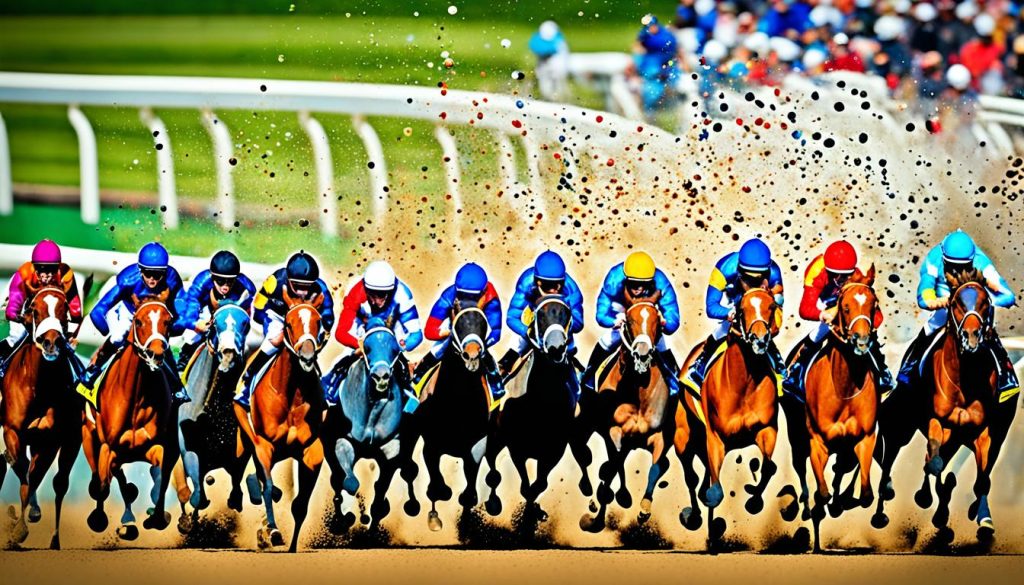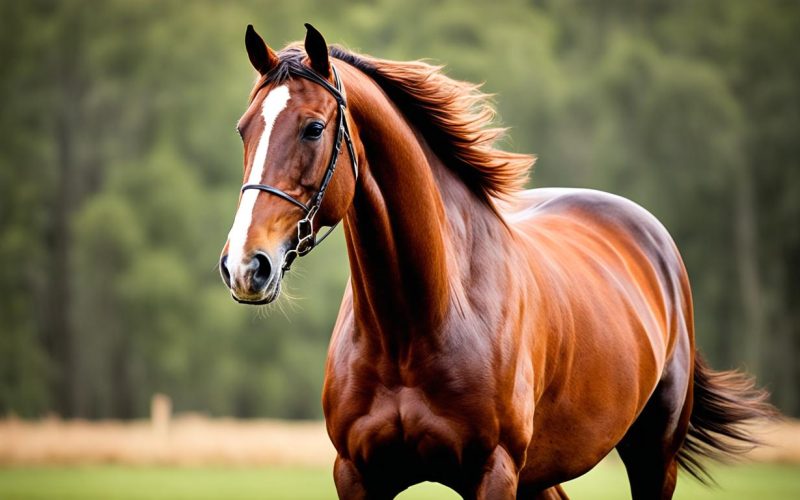Betting Strategies for Horse Racing
In the world of horse racing, having a solid betting strategy is crucial to increase your chances of success. Whether you’re a seasoned punter or a beginner, understanding the best betting strategies for horse racing can make a significant difference in your results.
But with so many strategies out there, how do you know which ones are the most effective? In this article, we will explore some of the best betting strategies for horse racing in the UK. From using a key horse to employing the dutching strategy, we’ll cover a range of techniques that can give you an edge when placing your bets.
But before we delve into the specific strategies, it’s important to remember that no strategy guarantees a win every time. Horse racing is a complex and unpredictable sport, and there will always be an element of risk involved. However, by employing these strategies and conducting thorough research and analysis, you can improve your chances of making successful bets.
Using a Key Horse
One effective horse racing betting strategy is to utilize a key horse. This strategy involves selecting one horse that you believe has the highest chance of winning a specific race and using it as the foundation for multiple bets. By placing bets centered around your key horse, you increase your potential for securing winnings.
For example, let’s say you identify the No. 1 horse as your key horse in a race. You can then choose other horses to finish second and third in an exacta or trifecta bet. By focusing on your chosen key horse, you optimize your betting strategy to align with your confidence in its potential to win.
Using a key horse strategy can provide a structured approach to your horse racing bets and increase your chances of success. It allows you to make strategic decisions based on your insights and analysis of a specific horse’s capabilities and past performance.
Implementing a key horse strategy can be a valuable tool in your horse racing betting arsenal. It enables you to make calculated and confident bets, maximizing your potential for winning.
Dutching Strategy
Another strategy that can be effective in horse racing betting is the dutching strategy. This approach involves selecting multiple horses in a race to increase your chances of winning. By spreading your stake across these horses, you can ensure a return regardless of which horse ultimately wins the race.
The dutching strategy is based on the principle of hedging your bets by distributing your stake among multiple contenders. This allows you to cover a wider range of possible outcomes and reduces the risk of losing your entire wager if your initial pick does not win.
To implement the dutching strategy, you need to carefully analyze the horses participating in a race and determine their relative chances of winning. By assigning an appropriate percentage or fraction to each horse, you can calculate the optimal amount to place on each contender. This ensures that your potential payouts are proportionate to the likelihood of each horse winning.
Here’s an example of how the dutching strategy works:
- Race: Greatwood Handicap Chase
- Horses: Black Op, Rouge Vif, Moon Over Germany
Based on your analysis, you assign the following probabilities to each horse:
| Horse | Probability |
|---|---|
| Black Op | 40% |
| Rouge Vif | 30% |
| Moon Over Germany | 30% |
Using these probabilities, you can determine the amount to bet on each horse to ensure an equal return regardless of the outcome:
| Horse | Bet Amount |
|---|---|
| Black Op | £40 |
| Rouge Vif | £30 |
| Moon Over Germany | £30 |
With this betting strategy, you have covered multiple horses and significantly increased your chances of winning. Even if your initial selection, Black Op, does not win, you still have a chance to make a profit if either Rouge Vif or Moon Over Germany emerges victorious.

The Yankee Bet
The Yankee bet is a popular horse racing betting strategy that offers a chance to win big by placing bets on four carefully selected horses. This strategy involves placing bets on all possible combinations of doubles, trebles, and an accumulator, giving you multiple opportunities to win.
Here’s how it works:
- Select four horses that you believe have a high chance of performing well in their respective races.
- Place a bet on each of the possible combinations:
- 6 doubles
- 4 trebles
- 1 accumulator (all four horses)
- If at least two of your selected horses win or place, you have a chance to win multiple bets.
The Yankee bet is an exciting strategy that offers the potential for significant returns, especially if you have strong judgment and select horses with high winning probabilities.
To visualize the Yankee bet strategy, take a look at the table below:
| Bet Type | Horse 1 | Horse 2 | Horse 3 | Horse 4 | Possible Bets |
|---|---|---|---|---|---|
| Double | Win | N/A | N/A | N/A | 6 |
| Treble | Win | Win | N/A | N/A | 4 |
| Accumulator | Win | Win | Win | Win | 1 |
| Total Bets | – | 11 | |||

By placing 11 bets in total, you have the potential to win significant profits if your selected horses perform well. It’s important to remember that not all four horses need to win in order for you to have winning bets. As long as at least two horses place or win, you can see a return on your wagers.
Next, we’ll explore other popular horse racing betting strategies, including exacta, trifecta, and superfecta betting.
Exacta, Trifecta, and Superfecta Betting
Another popular strategy in horse racing betting is to place exacta, trifecta, or superfecta bets. These bets add an extra layer of excitement and potential for big winnings by requiring you to accurately predict the finishing positions of multiple horses in a race.
An exacta bet involves selecting the first and second place finishers in the correct order. For example, if you believe Horse A will finish first and Horse B will finish second, you would place an exacta bet on “A to win, B to place”.
A trifecta bet goes a step further, requiring you to accurately predict the first, second, and third place finishers in the correct order. This type of bet offers even higher odds and potential payouts. For instance, if you correctly predict that Horse A will finish first, Horse B will finish second, and Horse C will finish third, you would place a trifecta bet on “A to win, B to place, C to show”.
A superfecta bet takes it to the next level, requiring you to accurately predict the first, second, third, and fourth place finishers in the correct order. This is a challenging bet, but the potential rewards can be substantial. For example, if you correctly predict the exact order of Horse A finishing first, Horse B finishing second, Horse C finishing third, and Horse D finishing fourth, you would place a superfecta bet on “A to win, B to place, C to show, D to complete”.
Using exacta, trifecta, or superfecta bets can be a fun and potentially lucrative way to engage with horse racing. These bets require careful analysis of each horse’s form, jockey performance, and track conditions to make accurate predictions. Remember to do your research and consider multiple factors before placing these types of bets.
Now, let’s take a look at an example of how these bets work:
| Horse | Exacta Bet | Trifecta Bet | Superfecta Bet |
|---|---|---|---|
| Horse A | ✔️ Win | ✔️ Win | ✔️ Win |
| Horse B | ✔️ Place | ✔️ Place | ✔️ Place |
| Horse C | ✔️ Show | ✔️ Show | |
| Horse D | ✔️ Complete |
In this example, you placed an exacta bet on Horse A to win and Horse B to place, a trifecta bet on Horse A to win, Horse B to place, and Horse C to show, and a superfecta bet on Horse A to win, Horse B to place, Horse C to show, and Horse D to complete.
By accurately predicting the finishing positions, you would have won on all three bets, increasing your chances of a significant payout.
Remember, exacta, trifecta, and superfecta betting involve higher levels of risk, but they also offer higher potential rewards. It’s essential to approach these bets with a strategic mindset and thorough analysis.

Boxing Bets
Another popular horse racing betting strategy is boxing bets. This strategy allows you to select multiple horses to finish in a certain position, such as first, second, or third, but in any order. By boxing your bets, you increase your chances of winning as long as the chosen horses finish in the specified position.
Boxing bets can be an effective strategy, especially when you believe that several horses have a high likelihood of finishing in the desired position. It provides more flexibility and coverage compared to traditional bets that require a specific order of finish.
However, it’s important to note that boxing bets can increase the cost of your wager. Since you are including multiple horses in each position, you will need to multiply the number of horses in each position to determine the total number of combinations. This increased cost should be considered when deciding on the stake for your bet.
Here’s an example to illustrate how boxing bets work:
| Boxing Bet Example | Number of Horses | Total Combinations |
|---|---|---|
| Boxed Exacta | 3 | 6 |
| Boxed Trifecta | 4 | 24 |
| Boxed Superfecta | 5 | 120 |
As shown in the example, the more horses you include in each position, the higher the number of combinations and the higher the cost of your bet. However, this also increases your chances of winning, making boxing bets a popular choice for many horse racing enthusiasts.
Remember to consider the odds and perform thorough research when selecting the horses to include in your boxing bets. Analyze their past performances, track conditions, and other relevant factors to make informed decisions and maximize your chances of success.

Importance of Surface and Track
When it comes to horse racing, understanding the surface and track conditions is vital for making informed betting decisions. Different horses perform better on different surfaces, such as firm or good-to-firm turf. By analyzing a horse’s previous form on a specific surface, you can gain valuable insights into its performance capabilities.
For example, some horses excel on firm turf, which provides a harder and faster racing surface. These horses have the stamina and speed to maintain a strong pace throughout the race. On the other hand, horses that perform well on good-to-firm turf prefer a slightly softer surface, allowing them to find better traction and maintain their fitness.
By considering the horse’s track preferences, you can develop effective betting strategies. Whether it’s a turf or dirt track, specific track conditions such as heavy, soft, or firm can greatly impact a horse’s performance. Some horses may struggle on wet or muddy tracks, while others thrive in such conditions.
Take a look at the table below to understand how different horses can excel on various surfaces and track conditions:
| Horse | Surface Preference | Track Condition Preference |
|---|---|---|
| Speedy Steed | Turf | Firm |
| Mud Master | Dirt | Heavy |
| Grass Gallop | Turf | Soft |
| All-Terrain Ace | Both | Versatile |
By considering these surface and track preferences, you can refine your betting strategy and increase your chances of success.
Remember, when it comes to horse racing, it’s not just about analyzing the horse’s form or the jockey’s experience. Paying attention to the surface and track conditions can provide valuable insights that can make a significant difference in your betting outcomes.
Key Takeaways:
- Different horses perform better on different surfaces and track conditions.
- Analyzing a horse’s previous form on a specific surface can provide valuable insights.
- Consider the horse’s preference for firm or soft turf, as well as track conditions like heavy or muddy.
- Refine your betting strategy by factoring in these surface and track preferences.
Trainer and Jockey Considerations
The trainer and jockey have a significant impact on a horse’s performance in horse racing. Certain trainers have proven themselves to be particularly skilled at preparing runners for specific tracks, resulting in better records at these courses. Likewise, some jockeys may excel in riding certain horses or have a preferred location for racing.
When considering a horse’s trainer, it is important to examine their track record and determine if they have had success at the racecourse where the upcoming race will take place. Trainers with a history of successful performances at a particular track demonstrate their ability to understand the nuances of the course and effectively prepare their horses for optimal performance.
Similarly, jockeys play a crucial role in a horse’s success on the track. Experienced jockeys develop an understanding of how to effectively guide and communicate with their mounts, maximizing their chances of victory. Some jockeys may have developed a successful partnership with specific trainers or have a knack for riding particular horses, further enhancing their capabilities on race day.
When analyzing jockeys, it is advisable to review their previous performances, paying attention to their success rates and ability to maintain a calm and composed demeanor in high-pressure situations. Jockeys who consistently perform well and handle the demands of training and racing demonstrate their skill and professionalism.
Consideration of both the trainer and jockey is vital when formulating betting strategies. By assessing their track records, expertise, and previous successes, bettors can gain valuable insights into the potential performance of a horse in an upcoming race.
| Trainer | Racecourse | Win Percentage |
|---|---|---|
| John Smith | Lingfield Park | 22% |
| Sarah Johnson | Newmarket | 18% |
| Michael Brown | Aintree | 15% |
Table: Trainer Performance at Various Racecourses
Signs of a Confident Horse
Observing a horse’s behavior pre-race can provide valuable insights into its confidence and readiness to perform. A calm and confident horse with a shiny coat is more likely to perform well compared to an anxious and jittery horse.
Confidence plays a key role in a horse’s racing performance. When you visit the racecourse, keep an eye out for the following signs that indicate a confident horse:
- Relaxed body language: A confident horse will display a relaxed posture, with their head held high and their ears forward. They will have a calm and steady rhythm in their movements.
- Bright and alert eyes: A confident horse will have bright and alert eyes, indicating focus and attentiveness.
- Smooth coat: A horse with a shiny and well-groomed coat is often a sign of good health and confidence.
- Positive interaction with handlers: Watch how the horse interacts with its handlers. A confident horse will cooperate willingly and show trust and respect towards its handlers.
- Confident stride: When the horse is being led or ridden, observe its stride. A confident horse will move with purpose and determination, exhibiting a smooth and effortless gait.
These observations can help you gauge a horse’s confidence level and make more informed betting decisions. Remember, a confident horse is more likely to give its best performance on the racecourse.
Importance of Research and Analysis
When it comes to betting on horse racing, thorough research and analysis are key elements that can significantly improve your chances of making successful bets. By dedicating time to gathering all the relevant information, you can make informed decisions and develop effective betting strategies.
Researching horses, trainers, jockeys, surfaces, and previous race performances is crucial to understand their strengths, weaknesses, and suitability for specific race conditions. This comprehensive analysis allows you to identify patterns and trends that can guide your betting choices.
Let’s take a closer look at the different aspects of horse racing that you should consider when conducting your research and analysis:
1. Horses
Thoroughly researching individual horses will give you insights into their form, fitness, and performance history. Consider factors such as recent wins, consistency, pace preferences, and their ability to handle different track conditions.
2. Trainers and Jockeys
Pay attention to trainers and jockeys who have a proven track record of success. Some trainers specialize in certain types of races or have a reputation for preparing horses to perform well on specific tracks. Similarly, experienced jockeys can significantly impact a horse’s performance and should be evaluated based on their past achievements.
3. Surfaces and Track Conditions
Every horse has preferences when it comes to track surfaces, whether it’s good turf, soft ground, or an artificial track. Analyzing a horse’s past performances on different surfaces will help you understand their level of comfort and ability to perform at their best.
4. Previous Race Performances
Studying a horse’s recent race performances can reveal valuable insights. Look for consistent form, improvement over time, or the ability to perform well after a break. Analyzing finishing positions, times, and margins of victory can help you assess a horse’s competitiveness.
By carefully considering these factors and conducting thorough research, you can uncover hidden opportunities and formulate effective betting strategies. It’s essential to use credible sources of information, such as racecards, racing publications, and trusted online resources.
Remember, successful betting in horse racing requires a combination of knowledge, analysis, and a strategic approach. So, invest the time and effort in researching and analyzing the various aspects of horse racing to increase your chances of making winning bets.
Take a look at the table below for an illustrative example of how research and analysis can impact your betting decisions:
| Horse | Trainer | Jockey | Recent Form | Track Preference |
|---|---|---|---|---|
| Magnificent Mover | John Smith | Emma Brown | 1st, 2nd, 3rd, 1st | Good turf |
| Rapid Racer | David Johnson | James Thompson | 4th, 1st, 2nd, 5th | All-weather |
| Speedy Sprinter | Lucy Wilson | Michael Davies | 3rd, 3rd, 4th, 2nd | Soft ground |
In this example, if you’re looking to place a bet on a race with good turf conditions, Magnificent Mover stands out as a strong contender due to their recent form and track preference. Analyzing such data can help you make more informed betting decisions.
Conclusion
To maximize your chances of winning in horse racing betting, it is crucial to employ effective strategies. By implementing key horses, dutching, Yankee bets, exacta/trifecta/superfecta bets, boxing bets, and considering surface and track conditions, trainer and jockey performance, as well as observing confident horses, you can develop a solid betting strategy.
Utilizing a key horse allows you to build multiple bets around a single selected winner, increasing your potential returns. Dutching, on the other hand, involves selecting multiple horses to ensure a return regardless of which horse wins the race. Yankee bets offer a chance to win by placing bets on different combinations of four horses in various races.
Placing exacta, trifecta, or superfecta bets requires predicting the precise finishing positions of multiple horses, while boxing bets provide flexibility in selecting horses to finish in a certain position regardless of the order. Additionally, considering the surface and track conditions, as well as the performance of trainers and jockeys, can offer valuable insights into the potential success of a horse.
Finally, observing a confident horse’s behavior pre-race can be an indication of its readiness to perform well. However, it is important to conduct thorough research and analysis of horses, trainers, jockeys, and previous race performances to make informed decisions when placing your bets. By combining these winning strategies and informed decision-making, you can increase your chances of success in horse racing betting.









